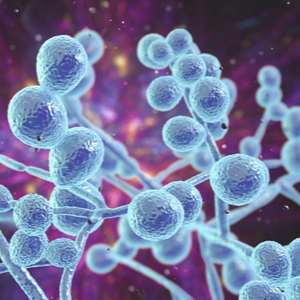
What are fungi?
Fungi are pathogens of infectious diseases. Depending on the type of fungus, they can infect humans, animals and also plants. Although there are many thousands of species of fungi, only about a few hundred fungal pathogens play a role in the transmission of infectious diseases in humans. These are mainly transmitted through the air, food or skin. Some types of fungi can infect the skin and nails, while others can penetrate the inside of the body and infect the lungs or intestines, for example. The most common fungal pathogens in Germany are the yeast fungus of the genus Candida (Candida albicans), skin fungi (Trichophyton rubrum) or moulds (Aspergillus fumigatus). Anti-fungal drugs (so-called antimycotics) for internal and external use are used to treat fungal diseases.
How are the different fungal diseases differentiated?
Infectious diseases caused by fungi are called mycoses by doctors and can be divided into the following categories:
- Type of pathogen: Which type of fungus caused the infection? Doctors use the so-called DHS system for human pathogenic fungi and distinguish between dermatophytes, yeast and moulds. While dermatophytes such as thread fungi only affect the skin and its appendages such as nails and hair, yeast and mould fungi can affect the skin as well as the mucous membranes and internal organs.
- Localisation: Which parts of the body are affected? Doctors distinguish between superficial fungal diseases (cutaneous) and subcutaneous fungal diseases (dermatomycoses). A further distinction is made between fungal diseases of the mucous membranes and fungal diseases that affect the internal organs (systemic mycoses). The latter can assume life-threatening proportions.
- Path of infection: How did the fungal pathogens get into the body? Doctors distinguish between so-called exogenous mycosis and endogenous mycosis. While exogenous mycosis is triggered by fungi that enter the body from outside, endogenous mycosis describes a fungal infection that originates from pathogens that have already been in the body.
- Primary or secondary fungal infection: How was the fungal disease triggered? A distinction is made between primary and secondary (opportunistic) mycosis. While a primary mycosis is a fungal disease that was triggered by direct transmission with the pathogenic fungi, a secondary mycosis describes a fungal infection that was triggered by another disease. This may be a bacterial infection, for example.
- Clinical picture: What is the external appearance of the fungus? This is the clinical picture, i.e. the appearance of the fungal infection such as its colour, its localisation and signs of inflammation.
How are fungi transmitted?
Fungi are ubiquitous. People can come into contact with them through food (such as bread, flour or potatoes), the skin, but also the air. The so-called Candida fungi are even constantly present on the skin, in the mouth or in the intestines of humans, without necessarily triggering disease symptoms or complaints. However, in the case of a weakened immune system or damage to the natural skin barrier, the Candida fungi can spread under certain circumstances and trigger diseases. Other ways in which fungi are transmitted are poor or excessive hygiene and numerous stress factors, as they weaken the body's own protective mechanisms.
Allergic reactions to fungi
Inhaling the spreading units of fungi, the so-called spores, can trigger an allergic reaction in some people. It all depends on where in the respiratory tract a hypersensitivity reaction takes place. Depending on this, for example, an allergic rhinitis, an allergic inflammation of the lung tissue (exogenous allergic alveolitis) or bronchial asthma can occur. Exogenous allergic alveolitis is also colloquially called "woodworker's lung" or "farmer's lung", as it particularly often affects these two occupational groups.
Fungal toxins
Fungi produce toxins called mycotoxins, which can have a toxic effect even in small doses. Humans can ingest these fungal toxins, for example, through food contaminated with toxin-producing fungi, such as mouldy yoghurt or ergot. The latter is a filamentous fungus (Claviceps purpurea) that mainly attacks rye and produces highly toxic alkaloids. In the Middle Ages in particular, ergot often led to mass deaths in cereals.
Since many mycotoxins are often heat-resistant, heating food does nothing to kill the fungal toxins. Mycotoxins have a damaging effect on the liver and kidneys and can sometimes also cause cancer. Aflatoxin, for example, promotes liver cell cancer.
How is a fungal infection treated?
Fungal infections are often treated with drugs called antimycotics. Antimycotics prevent fungi from building up a cell wall and thus hinder their growth (fungistatic effect), or they make holes in the cell wall and thus kill the fungus completely (fungicidal effect), as the components of the fungus are lost to the outside. Antimycotics are prescribed either for external or internal use. The particular form of application depends entirely on the type of fungus and its severity.
In addition to treatment with antimycotics, the following hygienic measures should also be followed to prevent the fungal pathogen from spreading:
- Only a separate towel should be used for the diseased skin areas.
- Certain textiles such as towels, underwear and stockings should be washed at 60 degrees to kill fungi.
- Bathing slippers should be worn in public buildings such as swimming pools, the sauna, in the shower area and in changing rooms to avoid walking barefoot.
- If there is a case of athlete's foot, doormats, floors and shoes should be disinfected regularly.
Are all fungi harmful?
There are also fungi that have a healing effect. One example is the grey-green mould penicillin (Penicillium notatum), which the English researcher Alexander Fleming discovered by chance in 1928. The so-called mould penicillin crept into Fleming's bacterial culture and destroyed it, from which Fleming concluded that penicillin might be able to save lives. As a result, Fleming's research and development of the world's first antibiotic, penicillin, began.
But traditional Chinese medicine (TCM) also uses the so-called shiitake or Judas ear (Mu-Err mushroom) as well as the crested thistle mushroom. The latter has the reputation of regulating blood sugar and fighting threadworms.
